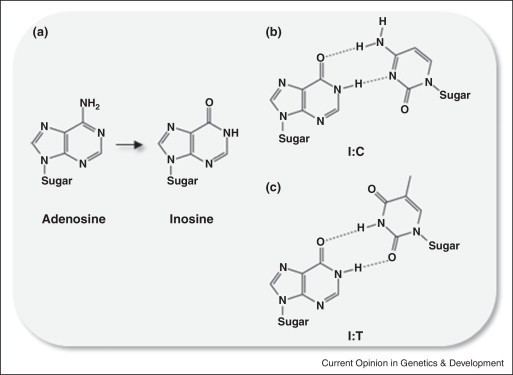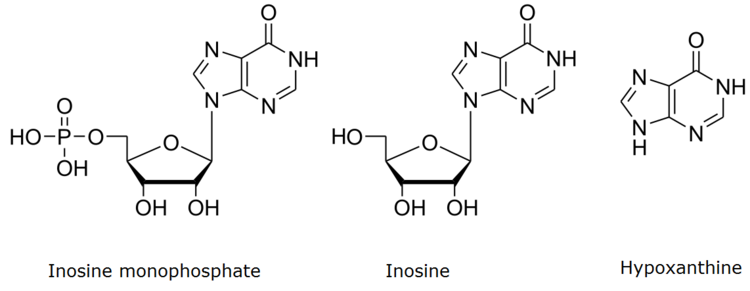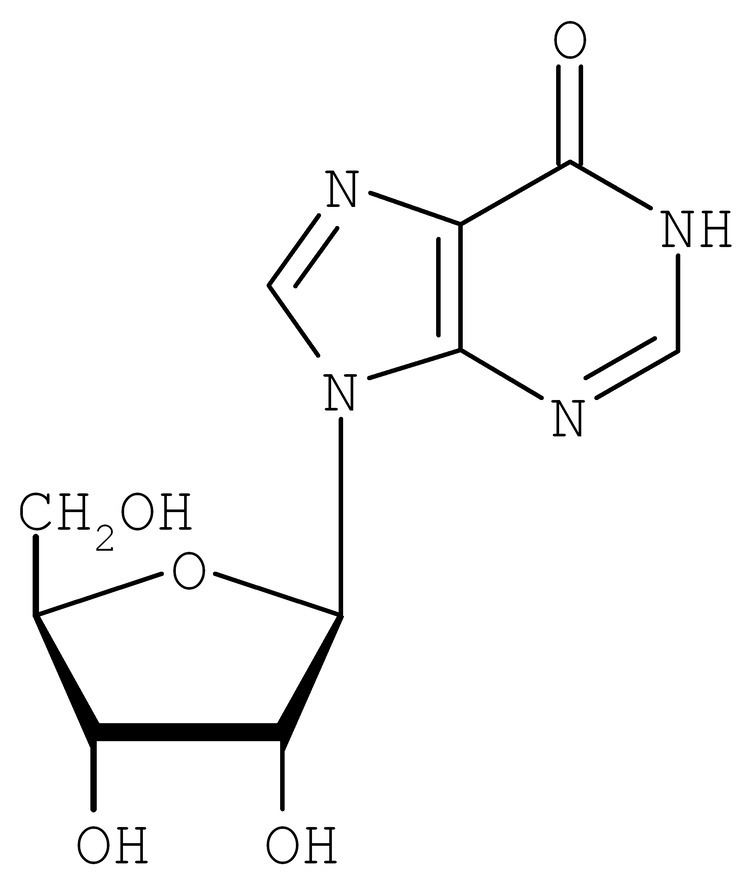Metabolism PubChem CID 6021 Molar mass 268.2261 g/mol | CAS Number 58-63-9 Formula C10H12N4O5 CAS ID 58-63-9 | |
 | ||
AHFS/Drugs.com International Drug Names ATC code D06BB05 (WHO) G01AX02 (WHO) S01XA10 (WHO) Legal status In general: Over-the-counter (OTC) | ||
Inosine is a nucleoside that is formed when hypoxanthine is attached to a ribose ring (also known as a ribofuranose) via a β-N9-glycosidic bond.
Contents

Inosine is commonly found in tRNAs and is essential for proper translation of the genetic code in wobble base pairs.

Knowledge of inosine metabolism has led to advances in immunotherapy in recent decades. Inosine monophosphate is oxidised by the enzyme inosine monophosphate dehydrogenase, yielding xanthosine monophosphate, a key precursor in purine metabolism. Mycophenolate mofetil is an anti-metabolite, anti-proliferative drug that acts as an inhibitor of inosine monophosphate dehydrogenase. It is used in the treatment of a variety of autoimmune diseases including granulomatosis with polyangiitis because the uptake of purine by actively dividing B cells can exceed 8 times that of normal body cells, and, therefore, this set of white cells (which cannot operate purine salvage pathways) is selectively targeted by the purine deficiency resulting from inherited metabolic diseases (IMD) inhibition.

Reactions

Adenine is converted to adenosine or inosine monophosphate (IMP), either of which, in turn, is converted into inosine (I), which pairs with adenine (A), cytosine (C), and uracil (U).
Purine nucleoside phosphorylase intraconverts inosine and hypoxanthine.
Inosine is also an intermediate in a chain of purine nucleotides reactions required for muscle movements.
Clinical significance

It was tried in the 1970s in Eastern countries for improving athletic performance. Nevertheless, the clinical trials for this purpose showed no improvement. It has been shown that inosine has neuroprotective properties. It has been proposed for spinal cord injury; because it improves axonal rewiring, and for administration after stroke, because observation has shown that axonal rewiring is encouraged.
After ingestion, inosine produces uric acid that is suggested to be a natural antioxidant and a peroxynitrite scavenger with potential benefits to patients with multiple sclerosis (MS). Peroxynitrite has been correlated with axon degeneration [1]. In 2003, a study was initiated at the University of Pennsylvania MS Center to determine whether raising the levels of uric acid by the administration of inosine would slow the progression of MS. The study was completed in 2006 but the results were not reported to NIH. A subsequent publication hinted at potential benefits but the sample size (16 patients) was too small for a definitive conclusion. In addition, the side effect of the treatment was the development of kidney stones in four of 16 patients. Thus, additional studies are necessary to prove the treatment's efficacy.
Its phase II trials for Parkinson's disease is now ended, it will continue to phase III trials. Earlier trials had suggested those with the highest serum urate levels had lower progression of Parkinson's symptoms. The trial uses inosine to raise urate levels in those with levels lower than the population mean (6 mg/dL).
Alseres Pharmaceuticals (named Boston Life Sciences when patent was granted) patented the treatment for stroke [2] and is currently investigating the drug in the MS setting.
In the Anatomical Therapeutic Chemical Classification System, it is classified as an antiviral.
Biotechnology
When designing primers for polymerase chain reaction, inosine is useful in that it can pair with any natural base. This allows for design of primers that span a single-nucleotide polymorphism, without the polymorphism disrupting the primer's annealing efficiency.
However, inosine pairs preferentially with cytidine (C) and its introduction to RNA, e.g. by the action of ADARs, thereby destabilizes double-stranded RNA by changing AU base-pairs to IU mismatches.
Fitness
Despite lack of clinical evidence that it improves muscle development, inosine remains an ingredient in some fitness supplements.
Feeding Stimulant
Inosine has also been found to be an important feed stimulant by itself or in combination with certain amino acids in some species of farmed fish. For example, inosine and inosine-5-monophosphate have been reported as specific feeding stimulants for turbot fry, (Scophthalmus maximus) and Japanese amberjack, (Seriola quinqueradiata). The main problem of using inosine and/or inosine-5-monophosphate as feeding attractants is their high cost. However, their use may be economically justified within larval feeds for marine fish larvae during the early weaning period, since the total quantity of feed consumed is relatively low.
